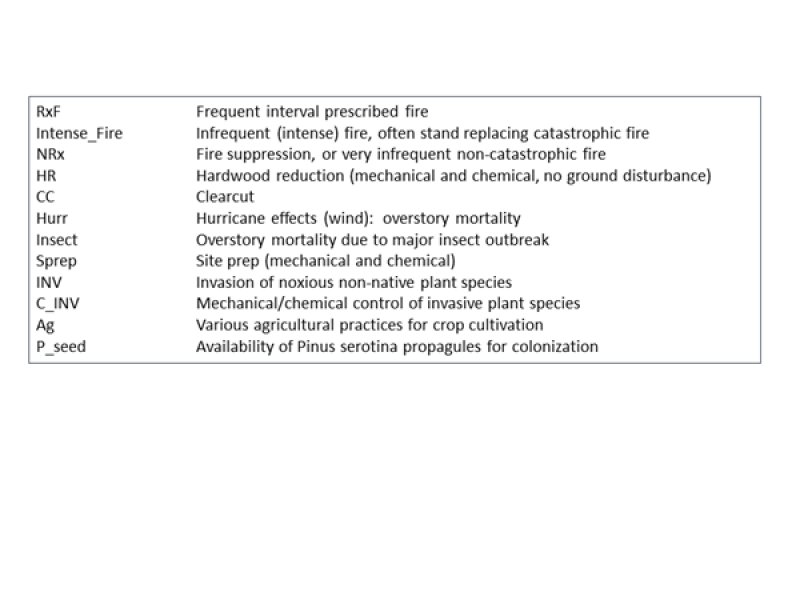
Natural Resources
Conservation Service
Ecological site F154XA006FL
Dry White Sand Scrubs
Last updated: 5/13/2025
Accessed: 12/21/2025
General information
Provisional. A provisional ecological site description has undergone quality control and quality assurance review. It contains a working state and transition model and enough information to identify the ecological site.
MLRA notes
Major Land Resource Area (MLRA): 154X–South-Central Florida Ridge
This MLRA makes up about 7,209 square miles (18,672 square kilometers) and is entirely in Florida. MLRA 154 contains a series of parallel, prominent sandy ridges of Pleistocene marine origin, including the Brooksville and Mount Dora Ridges. These north to south oriented parallel ridges are interspersed with more low lying physiographic provinces, including: upland hills, plains, valleys and gaps (Puri and Vernon 1964).
Many of the soils in this sub-unit are Pleistocene or Holocene sands that are underlain with older, loamy Pliocene marine sediments (Cypresshead formation) or the clayey Miocene marine sediments (Hawthorne formation). A combination of marine depositional events and the dissolution of underlying limestone (karst geology) is responsible for surficial topography throughout Peninsular Florida.
Classification relationships
All portions of the geographical range of this site falls under the following ecological / land classifications including:
-Environmental Protection Agency’s Level 3 and 4 Ecoregions of Florida: 75 Southern Coastal Plain; 75c Central Florida Ridges and Uplands (Griffith, G. E., Omernik, J. M., & Pierson, S. M., 2013)
-Florida Natural Area Inventory, 2010 Edition: Scrub (State 1) and Xeric Hammock (State 2) (FNAI, 2010)
Ecological site concept
The central concept of the Dry White Sand Scrubs is very deep, white, acid sands that are infertile and droughty. The map unit components of this site occur on low gradient slopes of <5%. Soils are very deep, infertile, excessively drained sands (St. Lucie series). These sands are uncoated, droughty, white, and lack any evidence of a seasonal high water table.
This site is limited to the Central Valley, Mount Dora Ridge, and Marion Upland physiographic units in MLRA 154.
Associated sites
| R154XX001FL |
Yellow Sands Xeric Uplands These sites are excessively well drained and will occur on slightly higher, more xeric landscape positions |
|---|---|
| F154XX002FL |
Xeric Bicolor Sandy Uplands These sites are excessively well drained and will occur on slightly higher, more xeric landscape positions |
| F154XA003FL |
Dry Yellow Sands Pine Woodland These sites are excessively well drained and will occur on slightly higher, more xeric landscape positions |
| F154XA009FL |
Moist Basic Pine Uplands These sites are well drained and will occur on slightly lower, more mesic landscape positions |
Similar sites
| R154XX001FL |
Yellow Sands Xeric Uplands These sites will be found on slightly higher landscape positions with a depth to seasonal high water table greater than 152 cm. Natural vegetation, management, and land use history will differ drastically due to this very deep, undeveloped yellow sands upland site. |
|---|---|
| F154XX002FL |
Xeric Bicolor Sandy Uplands These sites will be found on slightly higher landscape positions with a depth to seasonal high water table greater than 152 cm. Natural vegetation, management, and land use history will differ drastically due to this very deep, undeveloped white and multicolor sands upland site. |
| F154XA003FL |
Dry Yellow Sands Pine Woodland These sites will be found on slightly higher landscape positions with a depth to seasonal high water table greater than 152 cm. Natural vegetation, management, and land use history will differ drastically due to this deep, undeveloped yellow sands upland site. |
Table 1. Dominant plant species
| Tree |
(1) Pinus clausa |
|---|---|
| Shrub |
(1) Quercus chapmanii |
| Herbaceous |
(1) Rhynchospora megalocarpa |
Click on box and path labels to scroll to the respective text.


